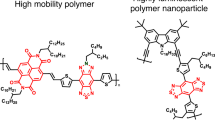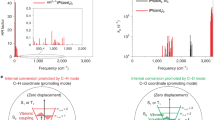Abstract
CONJUGATED polymers have been incorporated as active materials into several kinds of electronic device, such as diodes, transistors1 and light-emitting diodes2. The first polymer light-emitting diodes were based on poly(p-phenylene vinylene) (PPV), which is robust and has a readily processible precursor polymer. Electroluminescence in this material is achieved by injection of electrons into the conduction band and holes into the valence band, which capture one another with emission of visible radiation. Efficient injection of electrons has previously required the use of metal electrodes with low work functions, primarily calcium; but this reactive metal presents problems for device stability. Here we report the fabrication of electroluminescent devices using a new family of processible poly(cyanoterephthalylidene)s. As the lowest unoccupied orbitals of these polymers (from which the conduction band is formed) lie at lower energies than those of PPV, electrodes made from stable metals such as aluminium can be used for electron injection. For hole injection, we use indium tin oxide coated with a PPV layer; this helps to localize charge at the interface between the PPV and the new polymer, increasing the efficiency of recombination. In this way, we are able to achieve high internal efficiencies (photons emitted per electrons injected) of up to 4% in these devices.
This is a preview of subscription content, access via your institution
Access options
Subscribe to this journal
Receive 51 print issues and online access
$199.00 per year
only $3.90 per issue
Buy this article
- Purchase on Springer Link
- Instant access to full article PDF
Prices may be subject to local taxes which are calculated during checkout
Similar content being viewed by others
References
Burroughes, J. H., Jones, C. A. & Friend, R. H. Nature 335, 137–141 (1988).
Burroughes, J. H. et al. Nature 347, 539–541 (1990).
Braun, D. & Heeger, A. J. Appl. Phys. Lett. 58, 1982–1984 (1991).
Ohmori, Y., Uchida, M., Muro, K. & Yoshino, K. Jap. J. appl. Phys. 30, L1938–L1940 (1991).
Ohmori, Y., Uchida, M., Muro, K. & Yoshino, K. Jap. J. appl. Phys. 30, L1941–L1943 (1991).
Grem, G., Leditzky, G., Ullrich, B. & Leising, G. Adv. Mater. 4, 36–37 (1992).
Burn, P. L. et al. Nature 356, 47–49 (1992).
Holmes, A. B. et al. Synth. Met. 55–57, 4031–4040 (1993).
Friend, R. H., Bradley, D. D. C. & Holmes, A. B. Phys. World 5, 42–46 (1992).
Tang, C. W. & VanSlyke, S. A. Appl. Phys. Lett. 51, 913–915 (1987).
Adachi, C., Tsutsui, T. & Saito, S. Appl. Phys. Lett 57, 531–533 (1990).
Burn, P. L. et al. in Electrical, Optical, and Magnetic Properties of Organic Solid State Materials Vol. 245 (eds Chiang, L. Y., Garito, A. F. & Sandman, D. J.) 647–654 (Mater. Res. Soc. Symp. N, Pittsburgh, 1992).
Brown, A. R. et al. Appl. Phys. Lett. 61, 2793–2795 (1992).
Ohmori, Y., Uchida, M., Muro, K. & Yoshino, K. Solid St. Commun. 80, 605–608 (1991).
Doi, S., Kuwabara, M., Noguchi, T. & Ohnishi, T. Synth. Met. 55–57, 4174–4179 (1993).
Lenz, R. W. & Handlovitis, C. E. J. org. Chem. 25, 813–817 (1960).
Hörhold, H.-H. Z. Chem. 12, 41–52 (1972).
Burn, P. L. et al. J. chem. Soc., Perkin Trans. 1, 3225–3231 (1992).
Helbig, M. & Hörhold, H.-H. Makromol. Chem. 194, 1607–1618 (1993).
Karg, S. et al. in Proc. 6th Symp. on Unconventional Photoactive Solids Leuven, Belgium, 1993; also as Molec. Cryst. liq. Cryst. (in the press).
Dannetun, P. et al. Synth. Met. 55–57, 212–217 (1993).
Author information
Authors and Affiliations
Rights and permissions
About this article
Cite this article
Greenham, N., Moratti, S., Bradley, D. et al. Efficient light-emitting diodes based on polymers with high electron affinities. Nature 365, 628–630 (1993). https://doi.org/10.1038/365628a0
Received:
Accepted:
Published:
Issue Date:
DOI: https://doi.org/10.1038/365628a0
This article is cited by
-
Covalent Organic Frameworks with trans-Dimensionally Vinylene-linked π-Conjugated Motifs
Chemical Research in Chinese Universities (2022)
-
Praseodymium-Containing Polyfluorene: Synthesis, Photoluminescence, and Electroluminescence
Journal of Electronic Materials (2022)
-
Interaction of Light with Different Electroactive Materials: A Review
Journal of Electronic Materials (2022)
-
PPV-type π-conjugated polymers based on hypervalent tin(IV)-fused azobenzene complexes showing near-infrared absorption and emission
Polymer Journal (2021)
-
Versatile non-luminescent color palette based on guest exchange dynamics in paramagnetic cavitands
Nature Communications (2021)
Comments
By submitting a comment you agree to abide by our Terms and Community Guidelines. If you find something abusive or that does not comply with our terms or guidelines please flag it as inappropriate.



